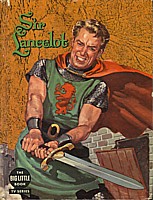
Sir Lancelot by Dorothy Haas (1958)
Based on the live-action television series.
Hardcover. Illustrated by Helmuth Wegner.
Whitman Books/Western Publishing Company
I wrote several blog posts earlier this year about the 1950s television series, The Adventures of Sir Lancelot. Not until I found the television series on Amazon last year did I ever get to watch it, but I’ve been familiar with the series since the late 1990s when I found in an antique shop a copy of the Big Little Book Sir Lancelot by Dorothy Haas, a tie-in with the television series, although not including the “Adventures” part of the name.
Having watched the television series, I decided to go back and read the book. Many of my readers will remember the Big Little Books series which was printed in the 1950s-1980s and popular during my childhood. The books have text on the left side and an illustration on the right hand page. They run between 200 and 300 pages – this book is 276 pages. This book is the only one I know of based on a television series, while most of the books were based on comic strips such as Mickey Mouse, Popeye, or the Pink Panther, superheroes like The Fantastic Four or The Incredible Hulk or popular culture movie characters like Tarzan and the Lone Ranger. I’ve always been fond of Big Little Books and still have a collection of several from my childhood.
The story of Sir Lancelot is not a repeat of any of the television episodes, but its plot is typical of the the TV series. Sir Lancelot and his squire Brian are at a tournament where Lancelot is defeated by a mysterious knight. Soon they are on an adventure when King Arthur sends Lancelot to investigate some raids in the Duke of Albemarle’s land. It turns out the duke has died and his son Garth is now the duke, but the Girth of Garth, a special belt signifying clan leadership, has gone missing. Lancelot and Brian must determine who the raiders are and get back the belt. In the process, they participate in a battle and Brian is attacked by a boar. Of course, all ends happily. There is some slight humor in the story but nothing about it is remarkable.
Surprisingly, no effort was made in the book’s illustrations to make Lancelot on the cover or the interior illustrations look anything like the series star William Russell. Nor does Brian look like his television counterpart. None of the illustrations really stands out, though they lack the cartoon look of most Big Little Books, and are colored in simple shading of one color each of blue, green, or yellow (By comparison, the earliest Big Little Books had fully colored cartoon illustrations and later versions were just black and white drawings). It’s also curious that the series ran from 1956-1957 but the book was not published until 1958.
Sir Lancelot is far from a great addition to Arthurian literature; it is a fun little, or should I say Big Little book, to read, but it’s also a rare case where the television series was better than the book. Despite the book’s flatness, author Dorothy Haas has had a very successful career as an author and editor and this was one of her first books. You can find out more about her at: http://www.illinoisauthors.org/authors/Dorothy_Haas. Among her other works were two Wizard of Oz books in the 1980s.
If you search online, you might be able to find a used copy of Sir Lancelot and the television series is available and worth watching.
______________________________________________________________________
Tyler Tichelaar, Ph.D. is the author of King Arthur’s Children: A Study in Fiction and Tradition. You can also visit him at www.ChildrenofArthur.com

